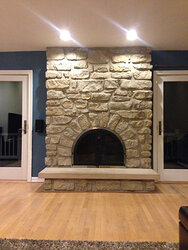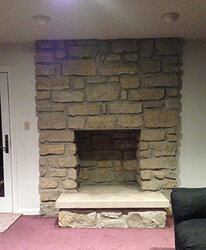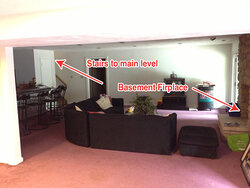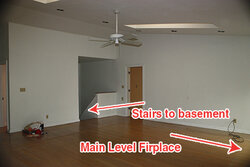Hi all,
First of all - AWESOME FORUM! I've been reading through for weeks and have gathered a TON of great info. Sorry - I tried to keep this short, but there's a lot to factor.
Here's what we've got:
Moved into a LARGE ranch (pushing 5,000 sq ft) this past fall. First floor is 2,800. We have propane heat and a propane water heater (not sure how much it uses?). The house is built and insulated really well - and I mean REALLY well. It was built using insulated concrete forms (ICF) in 1987. From the outside in, it's constructed of 2" of insulation, 10" of concrete, then 2" of insulation and finally, drywall. It's a wide open floor plan (great room, dining room, kitchen, and 3 bedrooms on first floor. High ceilings and I would say we get decent airflow. Lots of returns and ceiling fans in each bedroom and great room. There's an open staircase leading to the basement - which is fully finished and also wide open. Main floor and basement each have a fireplace on the outside wall, with the main floor fireplace directly on top of the basement's. I've burnt wood on the main floor - but obviously only for ambiance (I love burning fires). The one in the basement was built with the intent of installing an insert. It's only stone, no fire block and it has never been used. There's either a 10" or 12" tile flue going straight up and out.
Our goal is to reduce our propane bill, not necessarily heat the entire house with wood. I'd love to cut the bill in half if not more. We do have access to a ton of wood. I just need to cut and split - which I actually enjoy. Originally, my plan was to put the biggest/baddest wood burner in the basement since the fireplace is setup for an insert, making it an easy install. After reading through a ton of posts on here about others having problems heating from the basement in a ranch, I think the best thing to do is put the insert on the main floor. That's where we are 80% of the time.
I've attached a pics below of each fireplace (arched one is the main floor). I know floor plans help. I can draw some up and post if that helps. Just let me know.
I had local dealer come out yesterday. He suggested the Buck Model 94. However, I can't find much info on the 94.
Questions:
What would buy - and why?
Would you suggest Buck? Anyone like the 94? (Read some good things about the 91).
Would anyone suggest pellet instead of wood (considering my situation)?
Anyone suggest putting the insert in basement vs the main floor?
Any other info and/or opinions are definitely appreciated!
Thanks!


First of all - AWESOME FORUM! I've been reading through for weeks and have gathered a TON of great info. Sorry - I tried to keep this short, but there's a lot to factor.
Here's what we've got:
Moved into a LARGE ranch (pushing 5,000 sq ft) this past fall. First floor is 2,800. We have propane heat and a propane water heater (not sure how much it uses?). The house is built and insulated really well - and I mean REALLY well. It was built using insulated concrete forms (ICF) in 1987. From the outside in, it's constructed of 2" of insulation, 10" of concrete, then 2" of insulation and finally, drywall. It's a wide open floor plan (great room, dining room, kitchen, and 3 bedrooms on first floor. High ceilings and I would say we get decent airflow. Lots of returns and ceiling fans in each bedroom and great room. There's an open staircase leading to the basement - which is fully finished and also wide open. Main floor and basement each have a fireplace on the outside wall, with the main floor fireplace directly on top of the basement's. I've burnt wood on the main floor - but obviously only for ambiance (I love burning fires). The one in the basement was built with the intent of installing an insert. It's only stone, no fire block and it has never been used. There's either a 10" or 12" tile flue going straight up and out.
Our goal is to reduce our propane bill, not necessarily heat the entire house with wood. I'd love to cut the bill in half if not more. We do have access to a ton of wood. I just need to cut and split - which I actually enjoy. Originally, my plan was to put the biggest/baddest wood burner in the basement since the fireplace is setup for an insert, making it an easy install. After reading through a ton of posts on here about others having problems heating from the basement in a ranch, I think the best thing to do is put the insert on the main floor. That's where we are 80% of the time.
I've attached a pics below of each fireplace (arched one is the main floor). I know floor plans help. I can draw some up and post if that helps. Just let me know.
I had local dealer come out yesterday. He suggested the Buck Model 94. However, I can't find much info on the 94.
Questions:
What would buy - and why?
Would you suggest Buck? Anyone like the 94? (Read some good things about the 91).
Would anyone suggest pellet instead of wood (considering my situation)?
Anyone suggest putting the insert in basement vs the main floor?
Any other info and/or opinions are definitely appreciated!
Thanks!







